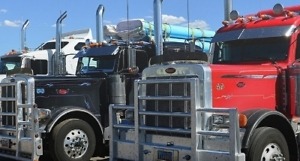Demand for truck parts rose last year, survey shows

John Blodgett, VP of Sales and Marketing, MacKay & Co
U.S. aftermarket demand for parts for Class 6-8 trucks, trailers and container chassis was $31.6 billion in 2019, a 5.7-percent increase from the year before, according to John Blodgett, vice president of sales and marketing at MacKay & Co., speaking at the Heavy Duty Aftermarket Dialogue in Dallas, Texas, Jan. 27.
Truck Part Purchases
He explained that 49 percent of truck parts purchases are happening at truck dealerships, with heavy-duty distributors accounting for another 18 percent. Independent repair garages are handling 9 percent of parts purchases. The rest are occurring at specialized dealerships, engine distributorships, auto parts stores and other locations.
MacKay is also forecasting a 1.5-percent increase in parts prices this year, and 1.2-percent growth for the aftermarket in 2020 compared to 2019. Looking to the future, Blodgett sees continued growth out to 2024, with 2021 parts sales reaching $33.4 billion, 2022 at $34.7 billion, 2023 at $35.9 billion and 2024 at $37 billion.
Because aftermarket parts and service consumption is based on vehicles in operation, Blodgett compared the 2018 truck population to that projected for 2024. He projects:
- The Class 6 operating population will reach 964,000 in 2024, a 13-percent increase over 2019’s 852,000.
- Class 7 trucks will see a 65-percent decline from 1.32 million in 2019 to 1.29 million in 2024.
- Class 8 trucks in operation will rise from 3.54 million in 2019 to 3.72 million in 2024, a 5-percent increase.
- Trailers will grow 6 percent from 4.72 million in 2019 to 5.01 million in 2024.
Total Service Labor Hours
Blodgett said that the total service labor hours dedicated to medium-duty, heavy-duty vehicles, trailers and container chassis totaled 650 million last year, growing from 627 in 2015. Based on survey results, he said, fleets are willing to travel more hours and miles to have service completed by outside providers than they have been in the past.
Enjoying our insights?
Subscribe to our newsletter to keep up with the latest industry trends and developments.
Stay InformedWhen factoring in service, the aftermarket money spent in the aftermarket breaks down as follows, according to MacKay:
- $65 billion or 56 percent in service labor (assuming labor at $100 an hour)
- Parts at $31 billion or 27 percent
- Tires at $11 billon or 9 percent
- Lubricants at $9 billion or 7 percent.
Looking Ahead
MacKay’s forecast for 2020 showed U.S. truck and trailer sales dropping but largely remaining above average levels. The projected 138,000 Class 6 and 7 truck sales would be down 10 percent compared to the 153,000 sold in 2019, but still above the 10-year average of 114,000 units. The same can be said for the forecast sales of 275,000 trailers that represent a 17-percent drop from the 331,000 sold in 2019, but still above the 257,000-unit average.
The drop in Class 8 truck sales is expected to be the most significant this year The 203,000 trucks expected to be sold in the U.S. would be 26 percent lower than 2019, sitting just under the 10-year average of 204,000 per year.
Other trends that will influence the aftermarket, Blodgett said, include:
- E-commerce parts purchasing: According to the MacKay survey, 12 percent of parts purchases are being made online, and that is expected to grow to 15 percent in three years
- Powertrains: While diesel is expected to continue to be the dominant fuel over the next decade, MacKay said it will drop from the current 88 percent to 76 percent, thanks to growth in electric and natural gas vehicles.
- Safety technology: Use of technology is growing, such as camera/video systems, lane departure warning, front-end collision avoidance/mitigation, and telematics.
(from HDT)


 MacKay is also forecasting a 1.5-percent increase in parts prices this year, and 1.2-percent
MacKay is also forecasting a 1.5-percent increase in parts prices this year, and 1.2-percent 



















